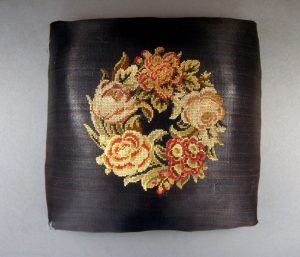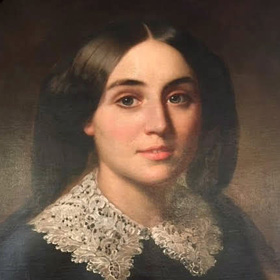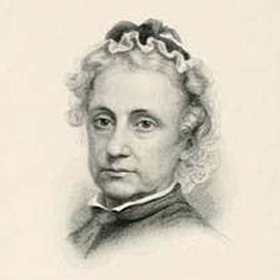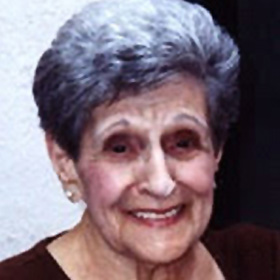Elizabeth Wrightington Marble (1825-1894) proved her mettle by joining her husband Captain John Marble on two whaling voyages – the Kathleen (1857-1860) and the Awashonks (1860-1862) out of New Bedford. Like a good diarist, she chronicled both trips and provided a clear glimpse into the reason for the voyages, the business of filling ships with whale oil.
Elizabeth Wrightington Marble (1825-1894) spent her early married life devoted to her family and proved her mettle by joining her husband Captain John Marble on two whaling voyages – the Kathleen (1857-1860) and the Awashonks (1860-1862) out of New Bedford. Like a good diarist, she chronicled both voyages, telling her side of the compelling story.
“I have stayed all night (at Brava) & slept on the ground with a straw mat and a sheet under me and a chare (sic) for a pillow. John’s pillow was a log of wood.” So went the first night’s attempted rest on a Cape Verdean island for Elizabeth Marble and her husband, Captain Marble, in October 1860. They were sailing toward the Cape of Good Hope on the Awashonks out of New Bedford on what would be their last voyage together. Elizabeth Church Wrightington was a Fall River girl, born in 1825 when the city was still called Troy, a village of Freetown. In 1845, at age 20 she married John Marble, who was 12 years older. John began as a green hand on board the Java of New Bedford in 1832. He swiftly rose through the ranks and by his sixth voyage was master of the Leonides; later, the Houghton in 1853, and the Helen Augusta Newport in 1854.
Elizabeth (called Lizzie by her husband and siblings) had lost their first child early in the marriage while John was at sea. In 1850 second son George “Freddie” Marble was born.
Their first voyage together as a family with their young son of seven years was on the bark Kathleen in 1857 – a ship “very poorly fitted out” with no gamboled bed (a frame suspended onto a set of swinging brackets to compensate for the rolling of the ship). Lizzie spread various pastes on her bed’s canvas base to discourage critters such as roaches and bedbugs, to no avail.
Through daunting living conditions, the industriousness of women sailing with their husbands on whalers (from around 1819 to the early 1920s) was remarkable and consistent, despite seasickness, rodents, insects, lack of fresh water (especially for washing), excessive dampness, and dangerous storms. Elizabeth Marble was surely no exception. Women accompanied their husbands on whalers sailing in all parts of the world: the North and South Atlantic, the Pacific and Indian Oceans, and Arctic waters. While docked off an island in the Indian Ocean, Elizabeth’s husband sent two whale boats out fishing. Lizzie took on the challenge and suffered face blisters and sunburn along with the crew.
She proudly recorded her prowess in selling goods for trade while docked in port. Her husband was even prouder saying, “you would ‘laft’ to see Lizzie tending store . . . she is what I call a shrude little body. Lest think keep shirts that cost .62 she had the face to take two dollars for and brest pin that cost .25 she would have $1.50 for . . .” Elizabeth, was said to insist on doing some cooking even when it meant a quarrel – no doubt from the cook whose single domain was the galley.
Elizabeth enjoyed collecting shells from all over the South Atlantic and Indian Oceans. Ella Doolittle, her granddaughter, said that Lizzie, “not content to gather them along the shore . . . sent her husband over the side” of the ship on a rope, so that she could collect the live animals, as their shells were judged to have the best color.

Elizabeth took a liking to whaling songs sung on board and carefully copied the lyrics for posterity. Elizabeth also engaged in sewing, creating a set of costumes for musicians in the crew, as well as fine needlepoint. The New Bedford Whaling Museum owns three lovely samples of her work, two footstools and a large chair.
Thanks to women’s journaling, a prominent feature of daily life for women in the 19th century, we get a clear glimpse into the reason they were on such voyages – the business of filling ships with whale oil. Here is a bird’s eye view from the Awashonks recorded by Elizabeth, a clearly keen observer:
Sunday, Jan 13: As soon as it was light, here was the whale, not a mile off . . . at 5 o’clock they lowered the boats . . . the mate struck one . . . the whale brushed his flukes against the (whale) boat and partly tipped it over as it came back it threw the line that lay in the head of the boat up and as it came down it came over the head of the boat steerer and took him out of the boat and carried him down . . . but he caught hold of an oar and as good luck would have it the iron came out of the whale. They got hold (of the) oar and hauled it up and him with it . . . he had 5 turns of the roap (sic) around his neck and waste; he is some jammed but we do not think there are any bones broken . . . if the iron had not drawn (out) we should never have seen him again.
The Awashonks went for six months without catching a single whale. Lizzie was clearly upset as she recorded her husband’s worries, depression, and weight loss. Captain John Marble acquired dysentery in October of 1861. He died several weeks later. Elizabeth was forlorn without him and recorded his last days in her journal. She also acquired dysentery but survived. It was said that Elizabeth conserved his body in whale oil and rum. He was returned home to Fall River’s Oak Grove Cemetery. Elizabeth lived to 69 years and died on Christmas Day 1894 in San Francisco. She was buried at Oak Grove with her husband. Their son George married Minerva Northrup and had four girls, Sarah, Mary, Ella, and Louiza. His family settled in western Massachusetts.
Nancy Gentile and Jenn Gady
A needlepoint cushion created by Elizabeth Marble is on display at New Bedford Whaling Museum as a part of the Re/Framing the View: Nineteenth-century American Landscapes exhibition through May 14, 2023.
Information from
-
Druett, Joan. Petticoat Whalers: Whaling Wives at Sea 1820-1920. University Press of New England, 2001.
-
“Elizabeth Church Wrightington.” FamilySearch, https://ancestors.familysearch.org/en/9WVH-74L/elizabeth-church-wrightington-1825-1894.
-
“Elizabeth Wrightington Marble.” Find a Grave, https://www.findagrave.com/memorial/92627744/elizabeth-marble.
-
Frank, Stuart M. “Captain John Marble.” Dictionary of Scrimshaw Artists. Mystic Seaport Museum, 1991.
-
“George Fredrick Marble.” FamilySearch, https://ancestors.familysearch.org/en/LWBN-BRG/george-fredrick-marble-1850-1904.
-
Lund, Judith. “Fall River Goes Whaling.” Coriolus, vol. 3, no. 2, 2012, pp. 1-14.
-
Marble, Elizabeth. Awashonks (Bark) of New Bedford, Mass., mastered by John C. Marble and then Hiram J. Cleveland, keeper Elizabeth Marble, on voyage 6 September 1860 – 4 April 1862. New Bedford Whaling Museum.
-
Marble, Elizabeth. “Gramp Marble’s Trips over Side of the New Bedford Whaler Started Fascinating Unusual Hobby for Local Woman.” Springfield Union, p. 14.
-
Marble, Elizabeth. Kathleen (Bark) of New Bedford, Mass., mastered by John C. Marble, keeper Elizabeth Marble, on voyage 25 August 1857 – 13 April 1860. New Bedford Whaling Museum.





